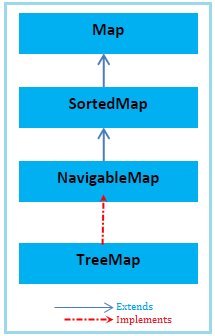| ☰ See All Chapters |
Java Map
A map is an object that stores associations between keys and values, or key/value pairs. Given a key, you can find its value. Both keys and values are objects.
The keys must be unique, but the values may be duplicated. Some maps can accept a null key and null values, others cannot.
The Map interface maps unique keys to values. A key is an object that we use to retrieve a value at a later date. Given a key and a value, we can store the value in a Map object. After the value is stored, we can retrieve it by using its key.
Maps revolve around two basic operations: get( ) and put( ). To put a value into a map, use put( ), specifying the key and the value. To obtain a value, call get( ), passing the key as an argument. The value is returned.
Although part of the Collections Framework, maps are not, themselves, collections because they do not implement the Collection interface. However, you can obtain a collection-view of a map. To do this, we can use the entrySet( ) method, to obtain a collection-view of the keys, use keySet( ).
They don’t implement the Iterable interface. This means that we cannot cycle through a map using a for-each style for loop and we can’t obtain an iterator to a map. However we can obtain a collection-view of a map, which does allow the use of either the for loop or an iterator.
There are many different implementations of the Map interface.
TreeMap.
HashMap.
LinkedHashMap.
Hashtable.
Properties
TreeMap
TreeMap is implementing SortedMap interface.
TreeMap uses tree data structure to store the keys.
The keys are stored in sorted order.
Only similar types of keys are allowed.
Different types of values are allowed.
Duplicate keys are not allowed but duplicate values are allowed.
Null keys are not allowed but null values.


TreeMap Example
TreeMapDemo.java
import java.util.SortedMap; import java.util.TreeMap;
public class TreeMapDemo {
public static void main(String[] args) { // Create a TreeMap TreeMap map1 = new TreeMap(); TreeMap map2 = new TreeMap(); // Add key/value to the TreeMap // TreeMap stores keys in sorted order map1.put(new Integer(103), "CCC"); map1.put(new Integer(105), "EEE"); map1.put(new Integer(102), "AAA"); map1.put(new Integer(101), "BBB"); map1.put(new Integer(104), "DDD");
map2.put("Manu", new Double(11.11)); map2.put("Likitha", new Double(22.22)); map2.put("Advith", new Double(33.33)); map2.put("Manjunatha", new Double(44.44)); // using same key will update or replace the value map2.put("Manu", new Double(99.99));
// can add different type of value in TreeMap map2.put("Hello", "HELLO");
// can put null value in TreeMap map2.put("Hello", null);
// cannot add null key in TreeMap // tm.put(null, "CLUSTER");
// cannot add different type of keys in TreeMap // tm.put(new Integer(10),new Integer(20)); System.out.println(map1); System.out.println(map2); // getting a value using a key Object e = map2.get("Manu"); System.out.println("Value of Manu is: " + e);
Object e1 = map2.get("Likitha"); System.out.println("Value of Likitha is: " + e1);
Object e2 = map2.get("Tom"); System.out.println("Value of Tom is: " + e2);
boolean b = map2.containsKey("Manu"); boolean b1 = map2.containsKey("Raju"); System.out.println("Key Manu is present: " + b); System.out.println("Key Raju is present: " + b1);
System.out.println(map2.containsValue("33.33")); System.out.println(map2.containsValue(new Double(33.33)));
// gives key/value from first to 50 and excludes 50 SortedMap hm = map1.headMap(new Integer(50)); System.out.println("Values of headMap: " + hm);
// gives key/value from 30 to last and includes 30 SortedMap tm = map1.tailMap(new Integer(30)); System.out.println("Values of tailMap: " + tm);
// gives key/value including start range 30 till end range excluding 70 SortedMap sm = map1.subMap(new Integer(30), new Integer(70)); System.out.println("Values of subMap: " + sm);
// deleting map2.remove("Hello"); System.out.println("Values in TreeMap after deleting: " + map1);
map2.clear(); System.out.println("Values in TreeMap after clearing: " + map1);
} } |
Output:
public class Test { {101=BBB, 102=AAA, 103=CCC, 104=DDD, 105=EEE} {Advith=33.33, Hello=null, Likitha=22.22, Manjunatha=44.44, Manu=99.99} Value of Manu is: 99.99 Value of Likitha is: 22.22 Value of Tom is: null Key Manu is present: true Key Raju is present: false false true Values of headMap: {} Values of tailMap: {101=BBB, 102=AAA, 103=CCC, 104=DDD, 105=EEE} Values of subMap: {} Values in TreeMap after deleting: {101=BBB, 102=AAA, 103=CCC, 104=DDD, 105=EEE} Values in TreeMap after clearing: {101=BBB, 102=AAA, 103=CCC, 104=DDD, 105=EEE} |
HashMap
HashMap uses hash table data structure to store the keys.
HashMap defines no any extra methods other than those inherited from Map Interface.
LinkedHashMap
LinkedHashMap store the keys in hash table data structure and links them with double linked list.
LinkedHashMap defines no any extra methods other than those inherited from Map Interface.
Hashtable
Hashtable can store key/value pairs.
It uses hash table data structure to store the keys.
Hashtable is a legacy class (Java 1.0) and it was extending Dictionary class.
Hashtable is re-engineered to fit into collection framework and is implementing Map interface and hence supports both 1.0 methods and 1.2 methods.
Hashtable is same as HashMap, but Hashtable is synchronized and HashMap is not synchronized.
Hashtable is synchronized; multiple threads cannot access the Hashtable object concurrently. Only one thread can access the Hashtable object at a specific time.
Since Hashtable is synchronized, it has low performance than HashMap.
Before to java 1.2 there was an interface called Enumeration to visit the elements of Hashtable. But now we have Iterator interface to visit the elements of Hashtable.
The keys will be unordered or undefined order.
Duplicate values are allowed.
Different types of keys and values are allowed.
Null keys and null values are not allowed.
All Chapters

